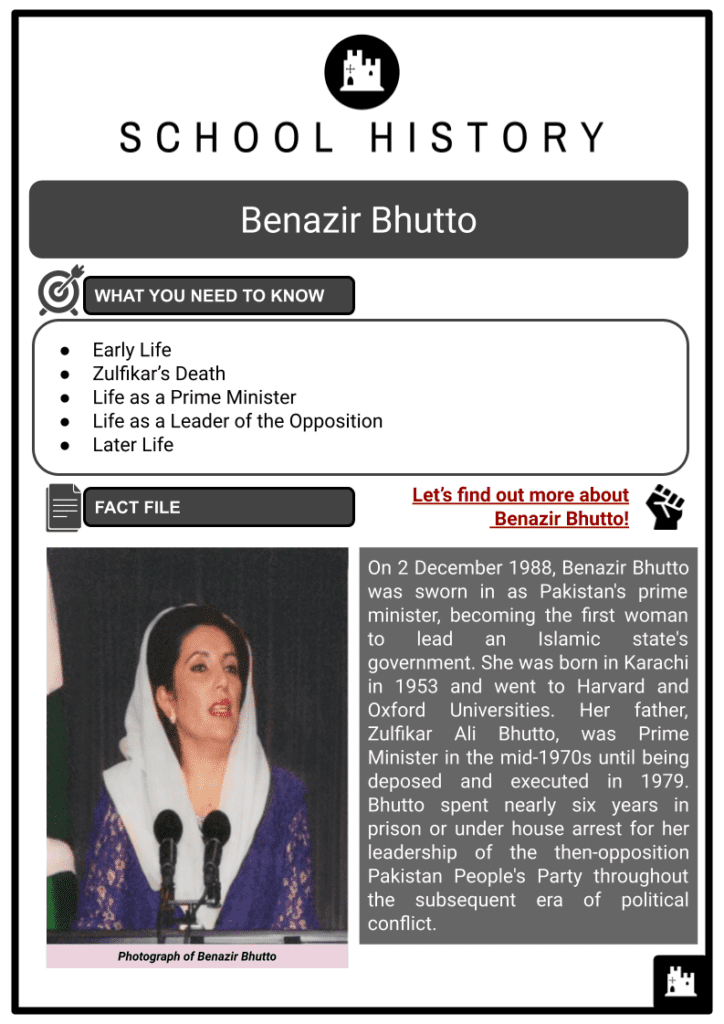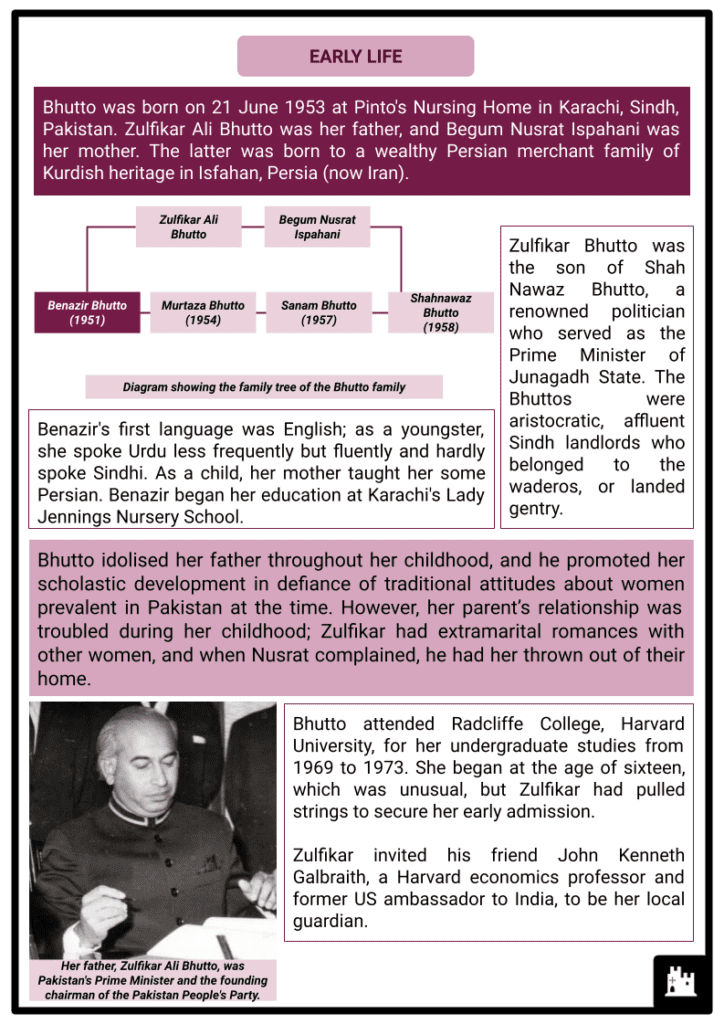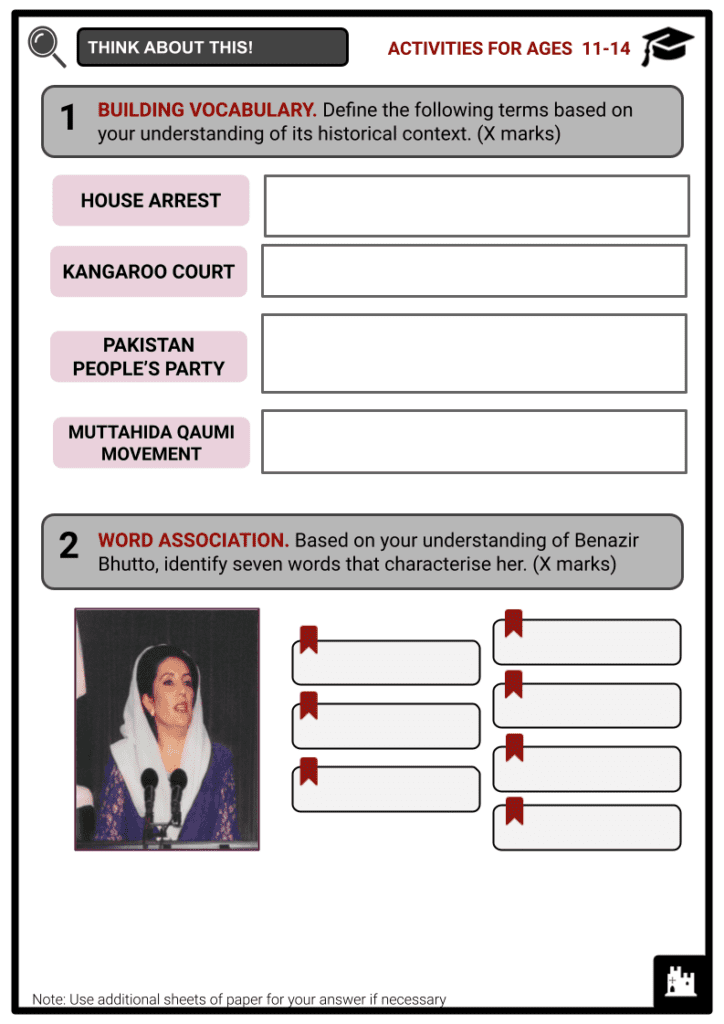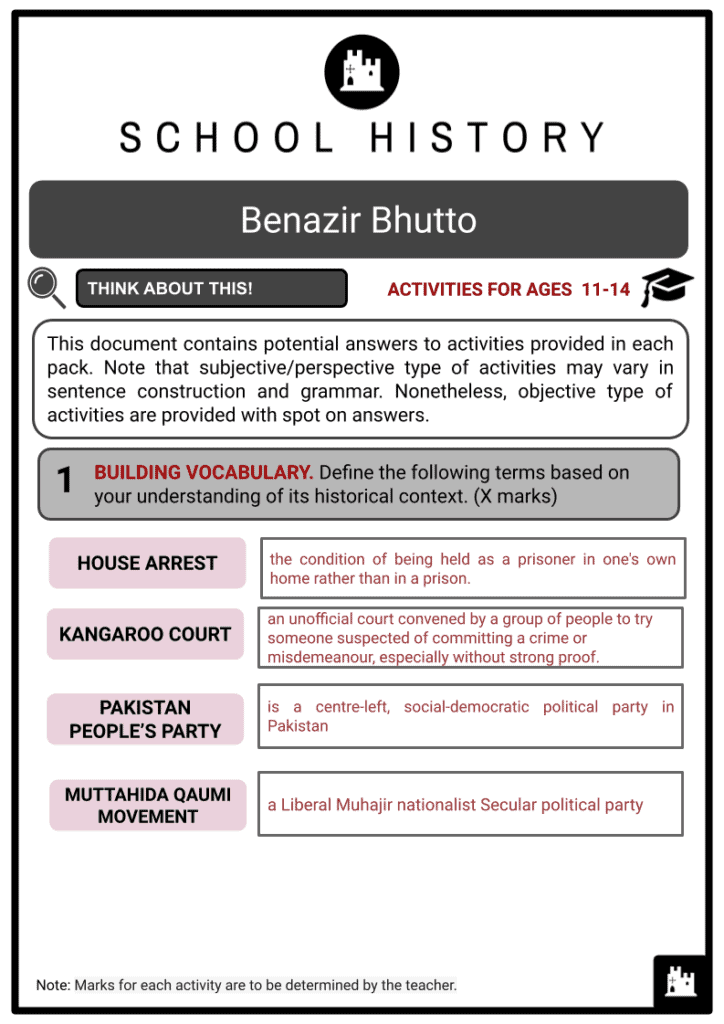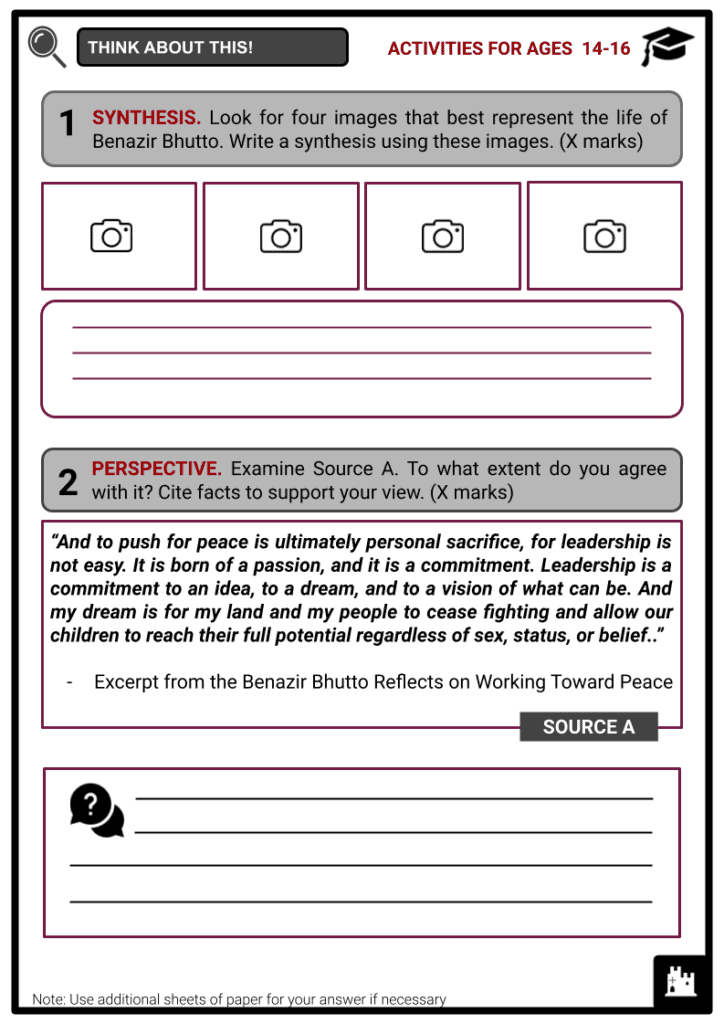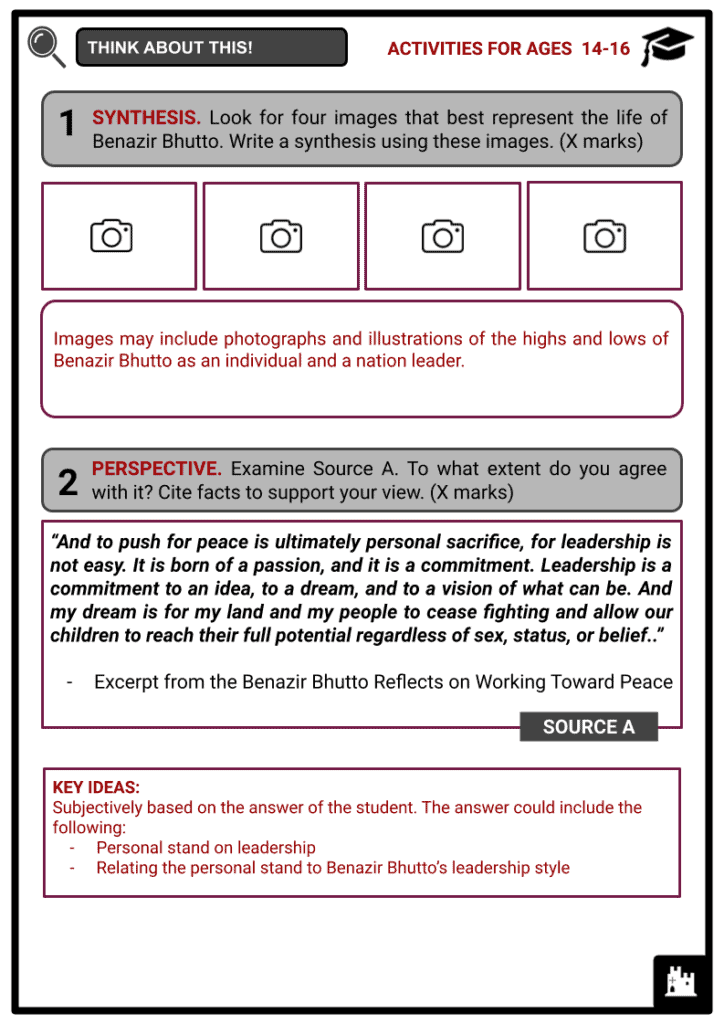Benazir Bhutto Worksheets
Do you want to save dozens of hours in time? Get your evenings and weekends back? Be able to teach about Benazir Bhutto to your students?
Our worksheet bundle includes a fact file and printable worksheets and student activities. Perfect for both the classroom and homeschooling!
Summary
- Early Life
- Zulfikar’s Death
- Life as a Prime Minister
- Life as a Leader of the Opposition
- Later Life
Key Facts And Information
Let’s find out more about Benazir Bhutto!
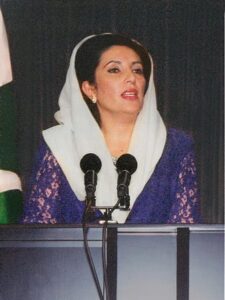
On 2 December 1988, Benazir Bhutto was sworn in as Pakistan's prime minister, becoming the first woman to lead an Islamic state's government. She was born in Karachi in 1953 and went to Harvard and Oxford Universities. Her father, Zulfikar Ali Bhutto, was Prime Minister in the mid-1970s until being deposed and executed in 1979. Bhutto spent nearly six years in prison or under house arrest for her leadership of the then-opposition Pakistan People's Party throughout the subsequent era of political conflict.
EARLY LIFE
- Bhutto was born on 21 June 1953 at Pinto's Nursing Home in Karachi, Sindh, Pakistan. Zulfikar Ali Bhutto was her father, and Begum Nusrat Ispahani was her mother. The latter was born to a wealthy Persian merchant family of Kurdish heritage in Isfahan, Persia (now Iran).
- Benazir's first language was English; as a youngster, she spoke Urdu less frequently but fluently and hardly spoke Sindhi. As a child, her mother taught her some Persian. Benazir began her education at Karachi's Lady Jennings Nursery School.
- Zulfikar Bhutto was the son of Shah Nawaz Bhutto, a renowned politician who served as the Prime Minister of Junagadh State. The Bhuttos were aristocratic, affluent Sindh landlords who belonged to the waderos, or landed gentry.
- Bhutto idolised her father throughout her childhood, and he promoted her scholastic development in defiance of traditional attitudes about women prevalent in Pakistan at the time. However, her parent’s relationship was troubled during her childhood; Zulfikar had extramarital romances with other women, and when Nusrat complained, he had her thrown out of their home.
- Bhutto attended Radcliffe College, Harvard University, for her undergraduate studies from 1969 to 1973. She began at the age of sixteen, which was unusual, but Zulfikar had pulled strings to secure her early admission.
- Zulfikar invited his friend John Kenneth Galbraith, a Harvard economics professor and former US ambassador to India, to be her local guardian.
- She became a Crimson Key Society campus tour guide and the social secretary of her dorm, Eliot House. She participated in an anti-American activity in the Vietnam War campaigns, including a Moratorium Day rally on Boston Common. She met people interested in second-wave feminism, although she was sceptical of some of the movement's viewpoints.
- Zulfikar urged her to join him in New York City in 1971, while she was a student at Harvard, for a United Nations Security Council meeting on the Indo-Pakistani War. After 13 years of military rule, Zulfikar Ali Bhutto became Pakistan's first democratically elected President in December 1971.
- Bhutto moved to the United Kingdom in the autumn of 1973 to pursue a second undergraduate degree in Philosophy, Politics, and Economics at Lady Margaret Hall, University of Oxford. She graduated with a second-class degree after three years.
- In 1977, she became the very first Asian woman to be elected as the President of the Oxford Union debating organisation. Following her Oxford education, she returned to Pakistan in June 1977 to serve at the "Inter-Provincial Council of Common Interests" and the Prime Minister's office.
ZULFIKAR’S DEATH
- Zulfikar Bhutto, who had just been re-elected in a general election, was deposed in a military coup headed by General Muhammad Zia-ul-Haq, the Chief of Army Staff, in July 1977.
- Both Zulfikar and Benazir thought that the US had aided Zia's coup. Zulfikar said that in a 1975 encounter, US envoy Henry Kissinger threatened him that if he did not stop Pakistan's nuclear programme, the US would make "a horrific example" of him.
- In September, Zulfikar was detained again and charged with the 1974 murder of Muhammad Ahmed Khan Kasuri, the father of Ahmed Raza Kasuri, a vocal critic of Zulfikar's government. Following the coup, Bhutto's brothers were dispatched abroad to rally international support for their father.
- Bhutto and her mother remained in Pakistan, despite being detained for brief durations on several occasions. She also helped prepare his defence case, which was heard by the Lahore High Court, which condemned him to death, and then by the Supreme Court, which upheld that conviction.
- Former United States Attorney General Ramsey Clark testified at the trial, claiming that it was a kangaroo court and that Zulfikar was not given a fair trial. Zulfikar begged his wife and daughter to flee Pakistan just before his execution, but they refused.
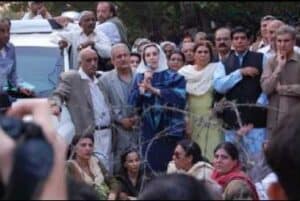
Photograph of Benazir Bhutto speaking to people outside her house during her house arrest. - In April 1979, he was executed by hanging. After being imprisoned for six months, Bhutto and Nusrat were released and placed under house arrest for another six months. The two women were finally freed in April 1980.
- Benazir replaced Zulfikar in the party after his death, becoming its co-leader. She formally created the Movement for the Restoration of Democracy (MRD) in February 1981, an organisation that brought the PPP together with other political parties in the country: Pakistan Muslim League, Pakistan Democratic Party, Pakistan MazdoorKisan Party, National Awami Party, QuomiMahaz-e-Azadi, Jamiat-i-Ulema-i-Islam, Tahrik-i-Istiqlal.
LIFE AS A PRIME MINISTER
- Zia disbanded the assemblies in May 1988 and ordered a November election. He didn't want Bhutto to win, and his choice of date may have been made on purpose to coincide with the date Bhutto was expected to deliver birth, limiting her ability to campaign. Zia died abruptly in August when his plane crashed shortly after takeoff from Bahawalpur Airport.
- Following Zia's death, the Supreme Court declared that the election will be held on a party basis, rather than the non-party basis that Zia had requested. Bhutto insisted on running the PPP independently of the MRD, abandoning its socialist programme in favour of economic Thatcherism and a devotion to the free market.
- Despite numerous challenges, Bhutto led the PPP to victory in the election, winning 93 of the 205 seats up for grabs. The opposing political party received only 54 seats, despite controlling Punjab, the country's largest and most influential region. This meant that the PPP held the most seats, but not a decisive majority.
- President Ghulam Ishaq Khan was legally required to invite Bhutto to form the new administration, but he declined. Under increasing pressure, especially from the United States, a vital ally, Assad reluctantly agreed two weeks after the election.
- Bhutto forged a partnership with the Muttahida Qaumi Movement (MQM), which had 13 seats in parliament, to create her administration, which enraged the Sindhi nationalist faction within her party. On 2 December 1988, she was sworn in as Pakistan's Prime Minister. Bhutto became Pakistan's second nationally elected Prime Minister and the first female Prime Minister in a Muslim-majority country.
- Bhutto's first cabinet was the most powerful in Pakistani history. She chose herself as the new finance minister, her mother as a senior minister without portfolio, and her father-in-law as chairman of the parliamentary public accounts committee. This dashed hopes that her administration would break with the country's established cronyism structures.
- When Bhutto became Prime Minister, one of the issues confronting Pakistan was high unemployment. The Pakistani government was bankrupt, thanks to Zia's use of high-interest loans to fund official salaries. At the time, Punjab province accounted for 60% of the country's population and was led by Zia's protégé, Nawaz Sharif, as provincial Chief Minister. Both Sharif and Bhutto attempted to depose each other, with Bhutto accusing Sharif of rigging the election to become Chief Minister.
- Opposition groups organised a parliamentary no-confidence vote in Bhutto's leadership in April 1989, but 12 votes lost it. Bhutto alleged that many National Assembly votes had been bribed to vote against her, with $10 million provided by Osama bin Laden, a Saudi Salafi cleric who wished to destabilise her government and replace it with an Islamic theocracy.
- As Prime Minister, Bhutto hesitated to question the ISI's assistance for Islamist mujahideen troops in Afghanistan, who were then fighting a civil war against the country's Marxist-Leninist government.
- The US was sending money to the mujahedeen through Pakistan but preferred to deal with Beg, Gul, and Ishaq Khan directly rather than through Bhutto. Gul led an invasion of Afghanistan in April 1989 to capture Jalalabad, which was to be transformed into a capital from which the country's anti-Soviet, Islamist-dominated resistance forces could operate.
LIFE AS A LEADER OF THE OPPOSITION
- Khan had demanded new elections. Meanwhile, Bhutto and her husband were barred from leaving Pakistan, despite purchasing an apartment in London's Queensgate neighbourhood.
- The PPP won 45 of the 217 seats in the 1990 general election. The IJI, led by Nawaz Sharif, obtained a majority in Parliament, and Sharif was appointed Prime Minister.
- Bhutto rose to the role of opposition leader. From this vantage point, she criticised Sharif's every policy, stressing his government's failures to address Pakistan's problems of poverty, unemployment, and a lack of healthcare, while ignoring her own administration's shortcomings on the same topics.
- As public discontent with Sharif's government mounted, the PPP began to reclaim the support it had lost during Bhutto's presidency.
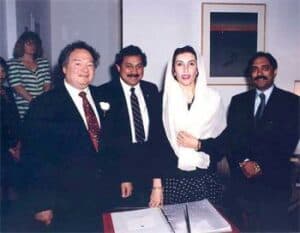
Bhutto with United States congressman Gary Ackerman at his office in Washington, c. 1990 - When India conducted its first nuclear test in 1998, Bhutto responded with an editorial in the Los Angeles Times arguing that the world community should go beyond imposing economic sanctions on India and instead execute a preemptive bomb strike on India's nuclear installations.
- Pervez Musharraf, the chairman of the Joint Chiefs of Staff, led a military coup that deposed Sharif in October 1999. Bhutto described the coup as "disturbing" and "distressing" but said it had removed Sharif, "an unpopular autocrat who was hounding the press, the courts, the opposition, and foreign businessmen."
- In June 1997, the Pakistani government formally requested that the Swiss government investigate Bhutto and her husband's financial accounts. In 1998, a Swiss magistrate, Daniel Devaud, seized a safe-deposit box containing a $190,000 necklace Bhutto had purchased the previous year in London's Bond Street.
- Bhutto, through a spokeswoman, said the claims against her amounted to a witch hunt and compared them to McCarthyism.
- Bhutto refused to fly to Switzerland to fulfill her sentence, and she fought the court verdict and got a retrial which overturned the prior ruling. However, Allen commented: "no one contended that the evidence had been rigged or that Bhutto and Zardari were not crooked on a massive scale."
LATER LIFE
- With the assistance of Socialist International secretary-general Luis Ayala, Bhutto and Sharif began a reconciliation process in 2006. Ayala saw this as necessary to ensure Pakistan's return to democratic elections.
- In October 2007, Bhutto returned to Pakistan, landing in Karachi. In the 2008 national elections, it was widely assumed that she would be the country's next Prime Minister.
- Bhutto highlighted the fundamental issue confronting her country as a struggle between "moderation and fanaticism," and she expressed concern about her safety.
- Bhutto met Afghan President Hamid Karzai on the morning of 27 December 2007. She spoke at a PPP rally in Rawalpindi's Liaquat National Bagh in the afternoon. She opened the car's escape hatch and got up to wave to the crowds as she drove away in a bulletproof vehicle. Within two to three metres of the automobile, a man fired three shots at her and exploded a suicide vest filled with ball bearings.
Image Sources
- https://en.wikipedia.org/wiki/File:Rueda_de_prensa_de_Felipe_Gonz%C3%A1lez_y_la_primera_ministra_de_Paquist%C3%A1n._Pool_Moncloa._14_de_septiembre_de_1994_(cropped_2).jpeg
- https://commons.wikimedia.org/wiki/File:Benazir_Bhutto_house_arrest_VOA_News.jpg
- https://en.wikipedia.org/wiki/File:Gary_Ackerman_and_Benazir_Bhutto.jpg

